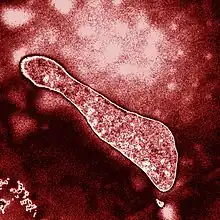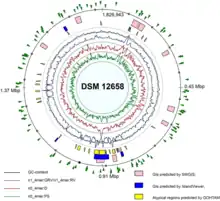| Ferroplasma | |
|---|---|
 | |
| Ferroplasma acidiphilum | |
| Scientific classification | |
| Domain: | |
| Kingdom: | |
| Phylum: | |
| Class: | |
| Order: | |
| Family: | |
| Genus: | Ferroplasma Golyshina et al. 2000 |
| Type species | |
| Ferroplasma acidiphilum Golyshina et al. 2000 | |
| Species | |
| |
Ferroplasma is a genus of Archaea that belong to the family Ferroplasmaceae. Members of the Ferroplasma are typically acidophillic, pleomorphic, irregularly shaped cocci.[1][2]
The archaean family Ferroplasmaceae was first described in the early 2000s.[3] To date very few species of Ferroplasma have been isolated and characterized. Isolated species include Ferroplasma acidiphilum, Ferroplasma acidarmanus, and Ferroplasma thermophilum.[1][4] A fourth isolate Ferroplasma cupricumulans was later determined to belong to a separate genus.[5][6] All known Ferroplasma sp. are iron-oxidizers.
Cell characteristics and Physiology

Ferroplasma cells are pleomorphic and lack a cell-wall.[2] All known members of the genera are acidophiles that thrive in environments where pH ranges from 0.0 to 2.0.[1][2] They are also mesophilic to moderately thermophilic with optimal temperatures ranging from 35-55 °C.[3]
Tetraether-based lipids are an important part of the Ferroplasma cellular membrane and allow cells to maintain a pH gradient. A study of F. acidarmanus found that cytoplasmic pH was maintained ~5.6 while the environmental pH ranged from ~0-1.2.[7] Variations in the tetraether lipids of the family Ferroplasmaceae are used for chemotaxonomic identification at the genus and species level because many members possess identical 16S rRNA sequences.[3]
Members of the genus Ferroplasma are chemomixotrophs that can oxidize ferrous iron to acquire energy, but despite evidence of carbon fixation, lab cultures often require an organic carbon source such as yeast extract for growth.[1][3] In the absence of iron, some lab-grown strains have been capable of chemoorganotrophic growth.[1]
Ecological Importance
Iron is the fourth most abundant mineral in Earth's crust. As iron-oxidizers Ferroplasma sp. participate in the biogeochemical of iron. Ferroplasma sp. are often identified at acid mine drainage (AMD) sites.[3] When ferrous iron (Fe2+) is oxidized to ferric iron (Fe3+) at mine sites, Fe3+ spontaneously reacts with water and iron-sulfur compounds like pyrite to produce sulfate and hydrogen ions.[8] During this reaction ferrous iron, which can be utilized by Ferroplasma, is also regenerated leading to a "propagation cycle" where pH is lowered. The reaction can be described by the following equation:
Ferroplasma species are often present at AMD sites where they participate in this cycle through the biotic oxidation of ferrous iron.[8]
Ferroplasma sp. may have important applications for bioleaching metals. Microbial bioleaching occurs naturally in the highly acidic environments that are home to Ferroplasma sp. Harnessing the power of bioleaching to recover metal from low quality ores and waste material is energetically advantageous compared to smelting and purifying.[9][10] It also produces fewer toxic byproducts. Studies have shown that the inclusion of Ferroplasma thermophilum along with the bacteria Acidithiobacillus caldus and Leptospirillum ferriphilum can bioaugment the leaching process of chalcopyrite and increase the rate at which copper is recovered.[11]
Isolated Species
Ferroplasma acidiphilum
Ferroplasma acidiphilum has been shown to grow as a chemomixotroph and to grow synergistically with the acidophilic bacteria Leptospirillum ferriphilum.[12] The strain Ferroplasma acidiphilum YT is a facultative anaerobe with all the required genes for arginine fermentation.[13] Although it is unclear whether Ferroplasma acidiphilum YT uses its arginine fermentation pathway, the pathway itself is an ancient metabolism that traces back to the last universal common ancestor (LUCA) of the three domains of life.[13][14]
Ferroplasma acidarmanus
Ferroplasma acidarmanus Fer1 was isolated from mine samples collected at Iron Mountain, California.[15] Iron Mountain (CA) is a former mine that is known for its acid mine drainage (AMD) and heavy metal contamination. In addition to being acidophilic, F. acidarmanus Fer1 is highly resistant to both copper and arsenic.[15][16]
Ferroplasma cupricumulans (formerly Ferroplasma cyprexacervatum)
In 2006 Ferroplasma cupricumulans was isolated from leachate solution collected from the Myanmar Ivanhoe Copper company (MICCL) mining site in Myanmar.[5] It was noted to be the first slightly thermophilic member of the genus Ferroplasma. However, in 2009 a new genus of acidophilic, thermophilic archaea, Acidiplasma, was identified. It was proposed that, based on 16S rRNA similarity and DNA-DNA hybridization, be transferred to the genus Acidiplasma and renamed Acidiplasma cupricumulans.[6]
Ferroplasma thermophilum
In 2008, Zhou, et al. described the isolation of the organism Ferroplasma thermophilum L1T from a chalcopyrite column reactor that was inoculated with acid mine drainage (AMD) from the Daye copper mine in China’s Hubei province.[4] In aerobic conditions with low concentrations of yeast extract F. thermophilum grows by oxidizing ferrous iron.[4] However, in anaerobic conditions F. thermophilum reduces ferric iron and sulfate.[4] This makes F. thermophilum ecologically important for iron and sulfur cycling at pyrite-rich mine sites.
See also
References
- 1 2 3 4 5 Dopson M, Baker-Austin C, Hind A, Bowman JP, Bond PL (April 2004). "Characterization of Ferroplasma isolates and Ferroplasma acidarmanus sp. nov., extreme acidophiles from acid mine drainage and industrial bioleaching environments". Applied and Environmental Microbiology. 70 (4): 2079–88. Bibcode:2004ApEnM..70.2079D. doi:10.1128/AEM.70.4.2079-2088.2004. PMC 383147. PMID 15066799.
- 1 2 3 Golyshina OV, Timmis KN (September 2005). "Ferroplasma and relatives, recently discovered cell wall-lacking archaea making a living in extremely acid, heavy metal-rich environments". Environmental Microbiology. 7 (9): 1277–88. doi:10.1111/j.1462-2920.2005.00861.x. PMID 16104851.
- 1 2 3 4 5 Golyshina OV (August 2011). "Environmental, biogeographic, and biochemical patterns of archaea of the family Ferroplasmaceae". Applied and Environmental Microbiology. 77 (15): 5071–8. Bibcode:2011ApEnM..77.5071G. doi:10.1128/AEM.00726-11. PMC 3147448. PMID 21685165.
- 1 2 3 4 Zhou H, Zhang R, Hu P, Zeng W, Xie Y, Wu C, Qiu G (August 2008). "Isolation and characterization of Ferroplasma thermophilum sp. nov., a novel extremely acidophilic, moderately thermophilic archaeon and its role in bioleaching of chalcopyrite". Journal of Applied Microbiology. 105 (2): 591–601. doi:10.1111/j.1365-2672.2008.03807.x. PMID 18422958. S2CID 25924161.
- 1 2 Hawkes RB, Franzmann PD, Plumb JJ (2006-09-01). "Moderate thermophiles including "Ferroplasma cupricumulans" sp. nov. dominate an industrial-scale chalcocite heap bioleaching operation". Hydrometallurgy. 16th International Biohydrometallurgy Symposium. 83 (1): 229–236. doi:10.1016/j.hydromet.2006.03.027.
- 1 2 Golyshina OV, Yakimov MM, Lünsdorf H, Ferrer M, Nimtz M, Timmis KN, et al. (November 2009). "Acidiplasma aeolicum gen. nov., sp. nov., a euryarchaeon of the family Ferroplasmaceae isolated from a hydrothermal pool, and transfer of Ferroplasma cupricumulans to Acidiplasma cupricumulans comb. nov". International Journal of Systematic and Evolutionary Microbiology. 59 (Pt 11): 2815–23. doi:10.1099/ijs.0.009639-0. hdl:10033/90258. PMID 19628615.
- ↑ Macalady JL, Vestling MM, Baumler D, Boekelheide N, Kaspar CW, Banfield JF (October 2004). "Tetraether-linked membrane monolayers in Ferroplasma spp: a key to survival in acid". Extremophiles. 8 (5): 411–9. doi:10.1007/s00792-004-0404-5. PMID 15258835. S2CID 15702103.
- 1 2 Madigan MT, Martinko JM, Bender KS, Buckley DH, Stahl DA (2015). Brock Biology of Microorganisms. United States of America: Pearson. pp. 652–653. ISBN 978-0-321-89739-8.
- ↑ Rohwerder T, Gehrke T, Kinzler K, Sand W (December 2003). "Bioleaching review part A: progress in bioleaching: fundamentals and mechanisms of bacterial metal sulfide oxidation". Applied Microbiology and Biotechnology. 63 (3): 239–48. doi:10.1007/s00253-003-1448-7. PMID 14566432. S2CID 25547087.
- ↑ Olson GJ, Brierley JA, Brierley CL (December 2003). "Bioleaching review part B: progress in bioleaching: applications of microbial processes by the minerals industries". Applied Microbiology and Biotechnology. 63 (3): 249–57. doi:10.1007/s00253-003-1404-6. PMID 14566430. S2CID 24078490.
- ↑ Zhang L, Wu J, Wang Y, Wan L, Mao F, Zhang W, Chen X, Zhou H (May 2014). "Influence of bioaugmentation with Ferroplasma thermophilum on chalcopyrite bioleaching and microbial community structure". Hydrometallurgy. 146: 15–23. doi:10.1016/j.hydromet.2014.02.013.
- ↑ Merino MP, Andrews BA, Parada P, Asenjo JA (November 2016). "Characterization of Ferroplasma acidiphilum growing in pure and mixed culture with Leptospirillum ferriphilum". Biotechnology Progress. 32 (6): 1390–1396. doi:10.1002/btpr.2340. PMID 27535541. S2CID 2765684.
- 1 2 Golyshina OV, Tran H, Reva ON, Lemak S, Yakunin AF, Goesmann A, et al. (June 2017). "T". Scientific Reports. 7 (1): 3682. doi:10.1038/s41598-017-03904-5. PMC 5473848. PMID 28623373.
- ↑ Zúñiga M, Pérez G, González-Candelas F (December 2002). "Evolution of arginine deiminase (ADI) pathway genes". Molecular Phylogenetics and Evolution. 25 (3): 429–44. doi:10.1016/S1055-7903(02)00277-4. PMID 12450748.
- 1 2 Baker-Austin C, Dopson M, Wexler M, Sawers RG, Bond PL (August 2005). "Molecular insight into extreme copper resistance in the extremophilic archaeon 'Ferroplasma acidarmanus' Fer1". Microbiology. 151 (Pt 8): 2637–2646. doi:10.1099/mic.0.28076-0. PMID 16079342.
- ↑ Baker-Austin C, Dopson M, Wexler M, Sawers RG, Stemmler A, Rosen BP, Bond PL (May 2007). "Extreme arsenic resistance by the acidophilic archaeon 'Ferroplasma acidarmanus' Fer1". Extremophiles. 11 (3): 425–34. doi:10.1007/s00792-006-0052-z. PMID 17268768. S2CID 12982793.
Further reading
- Grigor'eva NV, Tsaplina IA, Paniushkina AE, Kondrat'eva TF (25 September 2014). "[Optimization of bioleaching and oxidation of gold-bearing pyrite-arsnopyrite ore concentrate in batch mode]". Mikrobiologiia. 83 (5): 565–74. doi:10.1134/S0026261714040043. PMID 25844468. S2CID 14429161.
- Chen YT, Li JT, Chen LX, Hua ZS, Huang LN, Liu J, et al. (May 2014). "Biogeochemical processes governing natural pyrite oxidation and release of acid metalliferous drainage". Environmental Science & Technology. 48 (10): 5537–45. Bibcode:2014EnST...48.5537C. doi:10.1021/es500154z. PMID 24730689.
- Ohara K, Unno H, Oshima Y, Hosoya M, Fujino N, Hirooka K, et al. (August 2014). "Structural insights into the low pH adaptation of a unique carboxylesterase from Ferroplasma: altering the pH optima of two carboxylesterases". The Journal of Biological Chemistry. JBC Papers in Press. 289 (35): 24499–510. doi:10.1074/jbc.M113.521856. PMC 4148875. PMID 25043762.
- Gihring TM, Bond PL, Peters SC, Banfield JF (April 2003). "Arsenic resistance in the archaeon "Ferroplasma acidarmanus": new insights into the structure and evolution of the ars genes" (PDF). Extremophiles. Springer-Verlag. 7 (2): 123–30. doi:10.1007/s00792-002-0303-6. hdl:2027.42/42444. PMID 12664264. S2CID 16997297.
- Eppley JM, Tyson GW, Getz WM, Banfield JF (September 2007). "Genetic exchange across a species boundary in the archaeal genus ferroplasma". Genetics. 177 (1): 407–16. doi:10.1534/genetics.107.072892. PMC 2013692. PMID 17603112.
- Golyshina OV, Pivovarova TA, Karavaiko GI, Kondratéva TF, Moore ER, Abraham WR, et al. (May 2000). "Ferroplasma acidiphilum gen. nov., sp. nov., an acidophilic, autotrophic, ferrous-iron-oxidizing, cell-wall-lacking, mesophilic member of the Ferroplasmaceae fam. nov., comprising a distinct lineage of the Archaea". International Journal of Systematic and Evolutionary Microbiology. 50 Pt 3 (3): 997–1006. doi:10.1099/00207713-50-3-997. PMID 10843038.
- Madigan MT, Martinko JM (2005). Brock Biology of Microorganisms (11th ed.). Pearson Prentice Hall.
External links
- PubMed references for Ferroplasma
- PubMed Central references for Ferroplasma
- Google Scholar references for Ferroplasma
- NCBI taxonomy page for Ferroplasma
- Search Tree of Life taxonomy pages for Ferroplasma
- Search Species2000 page for Ferroplasma
- MicrobeWiki page for Ferroplasma
- LPSN page for Ferroplasma